|
|
|
|
|
Penguins:
All penguins are water birds, unable to fly. There
are various species of penguins, all tending to
live in colder climates. The 2 types that live near
McMurdo are the emperor and the adelie. Both are
oval-shaped with a black back and white tummy. They
have small appendages, a layer of blubber, and thick,
coarse feathers.
|
|
|
This
penguin is the largest and heaviest of all the different
species, weighing between 50 and 80 pounds, standing
around 3 and a half feet tall, and living more than
30 years. It can be distinguished from the other
species by the orange streak of feathers along its
neck. The main diet of the bird is krill (a critter
similar to a tiny shrimp), fish, and squid. The
emperor can dive the deepest of any bird, about
1500 feet and can hold its breath for 22 minutes.
Starting
with a 6 week prenuptial courtship, there is a 9
month breeding cycle. The female penguin lays one
egg on the seasonal sea ice in May or June (the
beginning of winter). The place chosen to lay the
egg is dependent upon the stability of the ice conditions
versus the distance to good feeding waters. After
laying her egg, the female then travels to the sea
to feed for the duration of the winter. The male,
on the other hand, just starts his job when the
winter begins. He stands with the egg tucked between
his belly flap and his feet to keep it warm. All
the males huddle together to help keep warm for
the entire winter (about 115 days) without even
taking a break to eat! Talk about a tough job. The
males are fasting for almost a third of a year!
The females return just prior to when their chicks
hatch and take over the parenting duties for a while.
Once the males have fed enough to recover from their
fast, they return to their mate and chick. There
is a mass movement of the population to a creche,
an enormous nursery for the entire colony. From
then on, the male and female take turns caring for
the chick and feeding in 2 or 3 week intervals.
The
emperor penguins I saw where chicks that had just
lost their down. They were being raised in captivity
to study their behavioral and learning patterns.
These penguins were chosen because they had a slim
chance of otherwise surviving.
Listen
to some emperor penguin calls.
|
|
|
These
penguins are much smaller than the emperors, they
stand about 1 and a half to 2 feet tall. The males
and females are of similar size and appearance.
I think that these birds are possibly some of the
cutest animals ever. They are very curious, silly,
and clumsy (on land). They travel quite a bit (in
groups), but always on the pack ice.
Krill
is the staple of their diet, but adelies also eat
fish, squid, and crustaceans. Even though they usually
feed in the upper 200 feet of the ocean, they are
able of going as far down as about 600 feet. Breeding
begins between October and March once the birds
reach the age of 3-5. The usual lifespan is about
20 years. Adelies lay 2 eggs in nests made from
small stones along the coast in regions of exposed
rock, raising both chicks provided there is enough
food available. Parents will travel from 5 to 120
km off the coast to catch food for their chicks.
After about 2 months, the chicks become independent
of their parents (imagine yourself at 2 months!).
I spotted adelies around McMurdo from time to time,
just roaming about. Most of the pictures here were
taken at a Cape Royds rookery on the north side
of Ross Island by Eun Oh.
|
|
|
The
South Polar Skua:
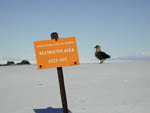
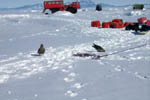
|
This
species of skua resembles a sea gull somewhat, although
it is noticeably larger. It has a white body and
brown wings with a white stripe across them. As
for the feet, they are large, leathery, webbed things.
South
Polar skua are fairly social and can be found in
groups to take baths or nest. The skua is a remarkably
aggressive bird. I have heard many tales of people
having their lunch stolen right out of their hands!
Cross a skua and they don't hesitate to dive-bomb
your head. They also possess the delightful attribute
of, when feeling threatened, vomiting on their attacker.
Good house pet, no? Skuas are scavengers, predominantly
dining on krill and fish. The south polar skua in
particular preys on the eggs and chicks of adelie
penguins.
They
actually breed on the Antarctic continent itself,
starting in the later part of October to sometime
in the middle of December. After incubating for
24 to 34 days, skua eggs hatch in late December
or January. A certain amount of the young and eggs
die of exposure (bad parents!). The nests can be
found in sheltered parts of rocky outcroppings;
they are just small depressions in the ground.
|
|
|
Antarctic
Cod:
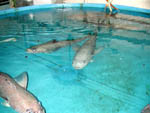
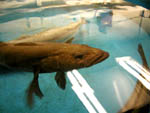
|
These
large, sluggish fish can be found swimming around
on the sea bottom, particularly near the shallow
water on the coast. Full grown, these grayish fish
are at least 3 feet long and weigh anywhere between
40 and 200 pounds (Yikes, I wouldn't want to meet
one of them underwater!). All spawning and fertilization
occurs externally.
A
rather unique feature of these fish is a compound
which can be found in their blood. Since fish are
cold-blooded, they depend on their environment to
keep them at an appropriate temperature. Since the
cod is living in waters at 28.8 Fahrenheit, there
is a very real danger of them freezing. The compound
in their blood is somewhat the similar to anti-freeze.
It works by making the temperature at which their
blood freezes slightly lower than the surrounding
water. So the only way they will freeze is if the
whole ocean freezes!
The
pictures of cod were taken by Elmer Sharp in the
aquarium.
|
|
|
The
Weddell Seal:
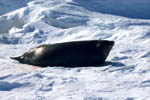
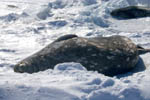
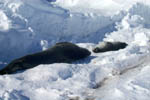
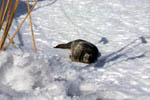
|
Weddell
Seals live the furthest south of any mammal and
also permanently inhabit the Antarctic continent.
These hardy critters are shaped rather like enormous
slugs (although significantly cuter), smallish heads
with large, blubbery bodies. They have a gray and
black dappled coat with a whiter tummy. The average
adult seal weighs between 800 and 1000 pounds and
is about 9 feet long.
Weddells
are both great navigators and divers. To find food,
the seals will swim down about as far as 2200 feet
and can go for 45 minutes without coming up for
air (wow!!!). Weddells are carnivores, commonly
eating fish, octopus, and prawns. They live under
the coast-bound ice, chewing away holes in the ice
in order to breath. In the summer, this is an easy
task because the ice is thin. However, in the winter,
this can be so difficult that seals sometimes wear
their teeth down to the point where they are unable
to feed. Breathing is a more immediate need than
eating! Once the seals reach maturity at age 6,
they start breeding. In October, pups weighing 50
to 60 pounds are born. In their very first week,
they learn to swim and get in and out of the water.
The pups are cared for by their mommas for 6 weeks
over which time they will gain about 220-280 pounds.
I
saw seals quite often by pressure ridges on the
way out to Willy Field. The photos shown here are
of a pup that got lost and accidentally visited
our lab and also from the Razorback Islands. They
seemed to spend most of their time on land sunning
themselves and napping.
|
|
|
|
|
|